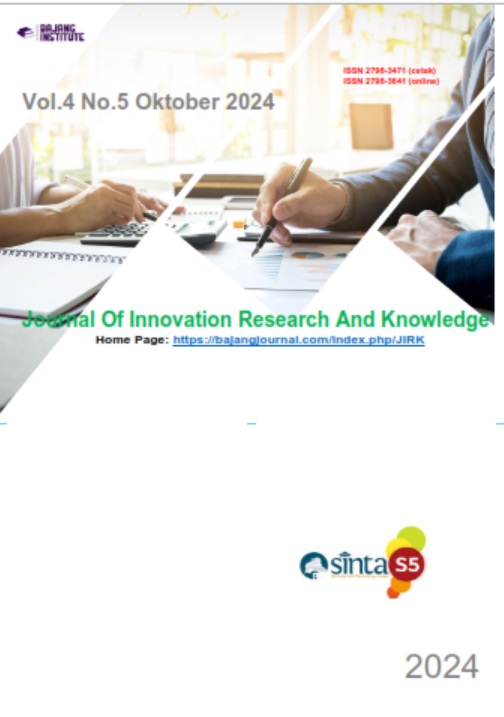EFFECT OF NIOBIUM ADDITION ON THE ELECTROCHEMICAL AND MECHANICAL PROPERTIES OF TITANIUM ALLOYS AS BIOMATERIALS
DOI:
https://doi.org/10.53625/jirk.v4i5.8694Keywords:
Titanium Alloy, Electric Arc Furnace, Corrosion Resistance, Mechanical PropertiesAbstract
Titanium is a metal known for its high strength, lightweight, and excellent corrosion resistance, making it widely used as a biomaterial in medical applications. To further enhance these properties, particularly corrosion resistance and mechanical strength, niobium (Nb) was added to titanium-aluminum (Ti-Al) alloys. In this study, three alloy compositions, Ti-5Al-10Nb, Ti-5Al-8Nb, and Ti-5Al-6Nb, were fabricated using the Electric Arc Furnace (EAF) method. After the melting process, the specimens were characterized using Scanning Electron Microscopy (SEM) combined with Energy Dispersive Spectroscopy (EDS) to analyze the microstructure and alloying element distribution. X-Ray Diffraction (XRD) was employed to identify the crystalline phases formed in the alloys. Electrochemical testing was performed using the Tafel polarization method to measure corrosion rates, while mechanical testing was conducted using the Vickers hardness test to determine material hardness.
The results showed that increasing niobium content in the titanium alloy significantly improved the corrosion resistance and hardness of the specimens. The Ti-5Al-10Nb specimen exhibited the lowest corrosion rate and highest hardness compared to the other specimens. These findings suggest that the addition of niobium can enhance the performance of titanium alloys as biomaterials, particularly for hip joint implant applications.
References
A, Paganotti, Bessa C.V.X., Silva L.S., and Silva R.A.G. "Metallic sample preparation for phase transformation analysis." MethodsX, 2019: 2348-2366
ASTM. "Standard Guide for Preparation of Metallographic Specimens." ASTM. 2017. https://www.astm.org/e0003-11r17.html (accessed August 24, 2024).
ASTM. "Standard Guide for Quantitative Analysis by Energy-Dispersive Spectroscopy." ASTM. 2019. https://www.astm.org/e1508-12ar19.html (accessed August 24, 2024).
ASTM. "Standard Reference Test Method for Making Potentiodynamic Anodic Polarization Measurements." ASTM. 2021. https://www.astm.org/g0005-14r21.html (accessed January 16, 2024).
ASTM. "Standard Test Methods for Vickers Hardness and Knoop Hardness of Metallic Materials." ASTM. 2023. https://www.astm.org/e0092-17.html (accessed July 5, 2024).
Bogdan, Huzum, and Puha Bogdan. "Biocompatibility assessment of biomaterials used in orthopedic devices: An overview (Review)." Experimental and Therapeutic Medicine, 2021.
Iuri, S. Brandt, I. Levartoski de Araujo Clodoaldo, Stenger Vagner, G. Delatorre Rafael, and A. Pasa Andre. "Electrical Characterization of Cu/Cu2O Electrodeposited Contacts." ECS Transactions, 2008: 413.
Matweb. Matweb. n.d. matweb.com (accessed August 20, 2024).
Mohammed, Mohsin Talib, Zahid A. Khan, and Arshad N. Siddiquee. "Beta Titanium Alloys: The Lowest Elastic Modulus for Biomedical Applications: A Review." International Journal of Chemical, Nuclear, Metallurgical and Materials Engineering 8, no. 8 (2014): 726-729.
National Library of Medicine. Melting Point in the Periodic Table of Elements. 2023. https://pubchem.ncbi.nlm.nih.gov/ptable/melting-point/ (accessed August 4, 2024).
Omazaki. Arc Flash: Definisi, Bahaya dan Resikonya. 2023. https://www.omazaki.co.id/arc-flash-definisi-bahaya-dan-resikonya/ (accessed June 8, 2024).
R, R Boyer. "Titanium and Its Alloys: Metallurgy, Heat Treatment and Alloy Characteristics." In Encyclopedia of Aerospace Engineering, 3-5. Seattle: John Wiley & Sons, Ltd., 2010.
Reddi, Alluru S. "Intravenous Fluids: Composition and Indications." In Fluid, Electrolyte and Acid-base Disorders, by Alluru S. Reddi, 39-54. Springer, 2023.
Y, Li, Yang C, and Zhao H. "New Developments of Ti-Based Alloys for Biomedical Applications." Materials, 2014: 1709-1800.













